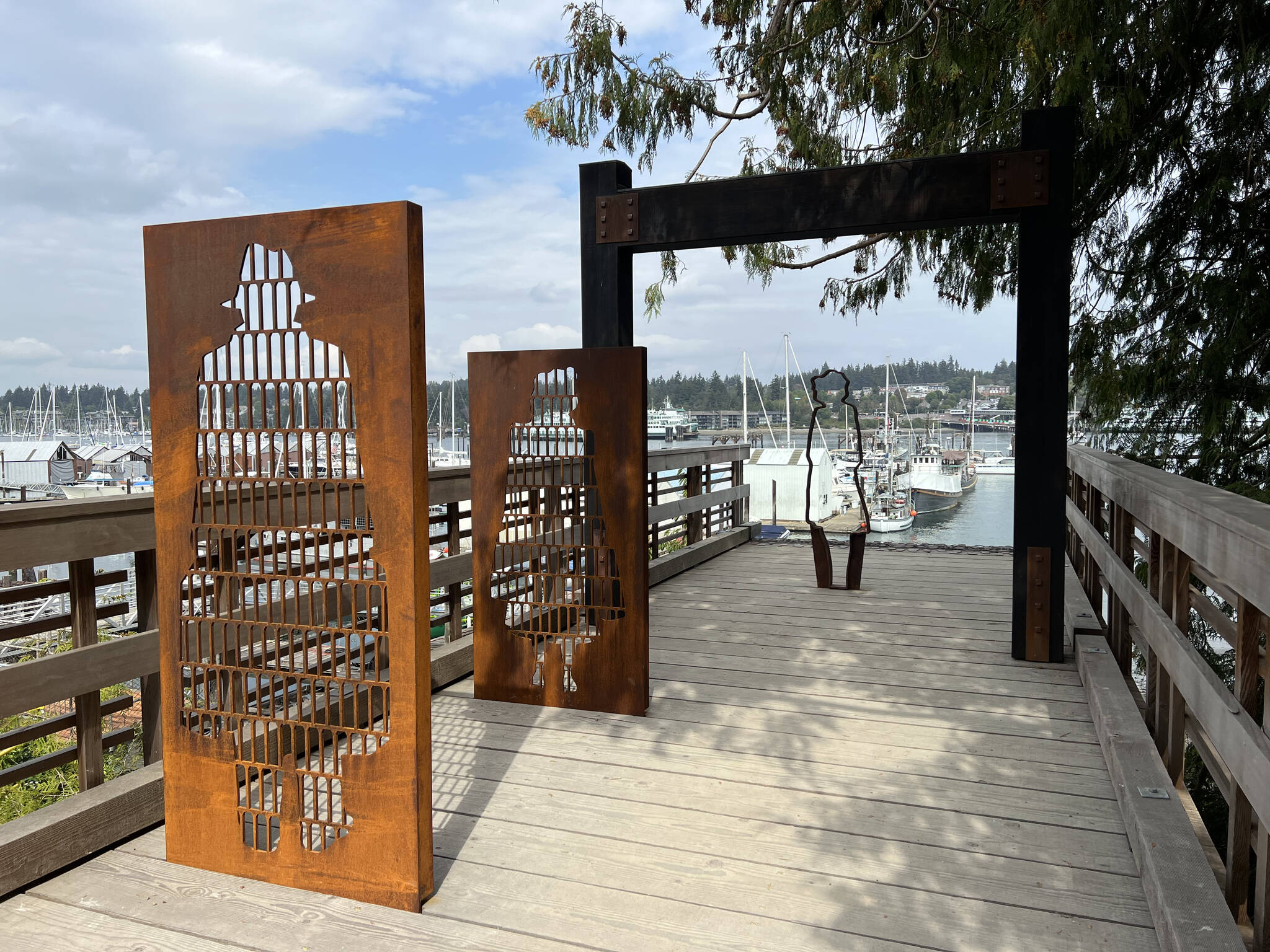Visitors to the Bainbridge Island Japanese American Exclusion Memorial can now retrace the final steps of those who were removed by armed soldiers March 30, 1942.
An interpretive artwork installed on the Departure Deck was dedicated Sept. 13 and marks the next-to-last step in development of the memorial site. The artwork consists of rusted steel sculptures made by Washington artists Anna Brones and Luc Revel, and an imposing gate by longtime memorial advocate John Buday.
Lilly Kodama, who was 7 at the time of the exclusion, served on the committee that chose the artists for this latest addition.
“Anna and Luc are the artists we chose because their submission showed that they understood what we wanted the artwork to convey—the awfulness of the event for our elders and their families leaving their homes and livelihoods for an unknown destination in an unknown duration. And yet, in spite of the fear and anxiety, they must have felt they went with quiet dignity occupied by armed soldiers.”
Kodama said she felt it was important to be part of the process and to share her perspective as a survivor who lived the experience. She hopes that visitors will be empathetic to how the elders must have felt when they walked onto the docks to board the ferry and leave. “I was a child at the time, but imagine how our people felt when they were uprooted from their homes, and they didn’t even know where they’re going to be taken.”
City Councilmember Clarence Moriwaki stressed the importance of the memorial in today’s incredible polarization and said that when the community started the memorial it had unanimous support.
“Back then, we had every member of Congress and the U.S. Senate, and the state legislature, red, blue, urban, rural, conservative, Republican, liberal — you know, they’re all together. Right now, it sounds like science fiction, but it really was true. And I think the reason why was the power of this story. That it was an error by our government. It’s considered one of the worst civil liberties violations and constitutional violations in American history.”
Moriwaki described the newest installation as completing the journey at the memorial. “You actually walk down this wall and experience the footsteps in history, of being taken away. This is your physical departure. But, we also hope that it will be an emotional departure and a connection to all the feelings that everyone felt at that time.”
As visitors enter the Departure Deck, they step on a metal plate that makes a loud, disturbing clunking noise, much like the sound of a jail cell closing. Artist Revel said it was intentional to bring sound into the project to help visually impaired visitors experience it, too. “That creates a lot of uneasiness when you step on something that moves, and you’re not expecting that.”
The entrance is flanked by tall silhouettes of soldiers holding rifles with fixed bayonets. Along the deck are several silhouettes with numerous name-tag-shaped cutouts walking toward the end where metal footprints line the end of the dock hanging in the air. The final silhouette is an outline or a “ghost’ walking toward the unknown.
Brones described the images on the deck. “That last one is sort of like she’s there, but she’s not there. We sort of like this vision to have somebody standing at the end where you see through and you just don’t know what’s next. That’s the power of art in general for us to use different mediums to get people to feel something, and that feeling elicits a sense of empathy that becomes a bridge to learning and understanding more about what happened to us.”
Inez Maubane Jones, executive director of Arts & Humanities Bainbridge, said she “was blown away. You are experiencing something that you can’t experience when you read (about it). This is so powerful. You feel this almost sense of disappearing…”
The sculptures depict the experience of the Japanese Americans during World War II after the bombings at Pearl Harbor. The artwork on the reconstructed Eagledale Ferry dock is a reminder of the day that 227 neighbors were forced from the island at that location and then taken to internment camps.
A grant state Sen. Christine Rolfes helped obtain was instrumental in guiding BIJAEMA through the process. Rolfes said the project started off small nearly two decades ago: a path to the water, and a plaque on a large stone. She said after 9-11 in 2001, “Islanders saw completely the threat of religious, cultural and racial intolerance that felt very similar to what had swept the nation in the 1940s.” As a result, plans for the memorial expanded.
Rolfes said the legislature awarded Bainbridge $1.5 million to purchase part of the memorial property and began the design. In 2005, the project received another $500,000 to start development of the wall and in 2018, the state approved $155,000 for the Departure Deck.
The installation of the newest art is an immersive project and succeeds in its aim to elicit a thoughtful and emotional response, she said. Rolfes added she “chokes up” when she speaks about the memorial, or the experience of the concentration camps.
“I don’t know if it’s because of empathy for the families that were impacted, admiration for the islanders who spoke their truth at that time or disappointment in my country. But, I know that part of it is that I’m so proud to live in a community that has spent two decades on a project that honors our elders, that learns from our past that would come together for so long to share our history and hopes of teaching our children and reminding ourselves not to make the same mistake. Next, and as importantly, when you see the mistakes being made to speak up,” Rolfes said.



